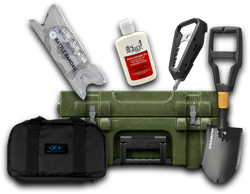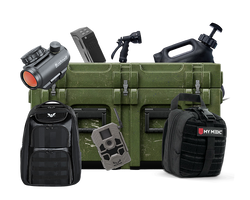
Surviving in the Desert
The desert is a beautiful yet unforgiving environment. It has some of the most unusual landscapes, wildlife, and plants in the world. With many people moving to and vacationing in desert regions, it is important to know the dangers of the desert and the precautions required to stay safe. Unprepared hikers can get lost, be caught in monsoons, get stung by poisonous animals, and face deadly dehydration. It can be a fatal mistake to underestimate the severity of the desert environment.
The threats of the desert should not be ignored, but they also should not prevent survivalists from enjoying their time in the desert. The key is understanding what to watch out for and how to give yourself the best chance to overcome an emergency situation:
Limit Sun Exposure. This is key! One of the biggest dangers in the desert is exposure to sunlight. Stay out of the sun during the middle of the day and always wear a head covering. Building a shade shelter is one of the first priorities to stay cool during the day. But before you start building, fashion a hat out of materials you have if you haven’t brought one with you. Exposing your head to sunlight can be dangerous because it forces your body to work overtime to cool down. When you get hot, don’t remove clothing in an attempt to cool down. Sunburn will lead to dehydration and overheating.
Ration Food and Water. Ration your water to last you as long as possible. The more you eat, the thirstier you get, so only eat enough to keep the hunger pains away. You can last longer without food than water, so limiting your food intake can help prevent dehydration. You can also limit water loss by breathing through your nose and covering your mouth with a bandana or piece of clothing to retain moisture.
Choose Safe Water Sources. Be cautious about the water you find. Use trees to indicate underground streams and look for rock indentations that store rainwater – these are the safest water sources. Avoid cactus water unless it is a life or death situation. Many cactuses don’t actually have any water inside, and those that do are often filled with alkaloids that cause cramping, vomiting, and diarrhea which can result in fatal dehydration.
Build a Warm Shelter for Nights. While the days in the desert are swelteringly hot, night temperatures often drop below freezing. First, look for caves that you can turn into a shelter. If there is nothing around, you will want to be below ground and away from the wind. Dig a body sized trench and line the rim with large rocks or other heavy objects. Cover it with a tarp or emergency blanket, secured by the rocks. Lining the bottom with an extra blanket or clothes can help increase insulation.
Look Out for Hazards. Major desert hazards include rattlesnakes, scorpions, spiders, sandstorms, and flash floods. When it comes to things that sting, always look where you step and check your shoes, sleeping bag, and anywhere you are about to sit. If you are stung by anything, reduce swelling by keeping the limb elevated. Understand how to treat snake bites if they occur. On windy days, be prepared for the potential of a sandstorm. Wear airtight goggles if you have them, or sunglasses. Dampen a bandana or piece of clothing to tie around your mouth and nose and stay inside whatever shelter you have constructed. If you are in an area with canyons, always be aware of flash flood potential. Most occur between noon and 8pm and monsoon season in the American southwest is July to September. However, if you are encountering significant rains outside of these timeframes, it is a good idea to sleep and travel in an elevated area if possible.
These key tips can help you have the best survival outcome if you find yourself in an emergency in a desert area. Always research the environment before hiking or camping and bring the right tools to set yourself up for success. In the desert, lack of preparation and underestimating your surroundings can both be fatal mistakes.
Share this article







